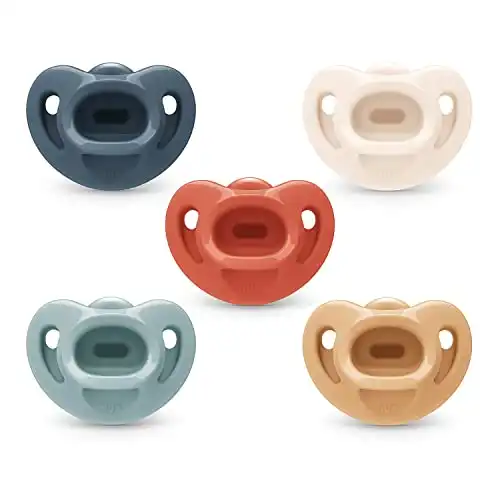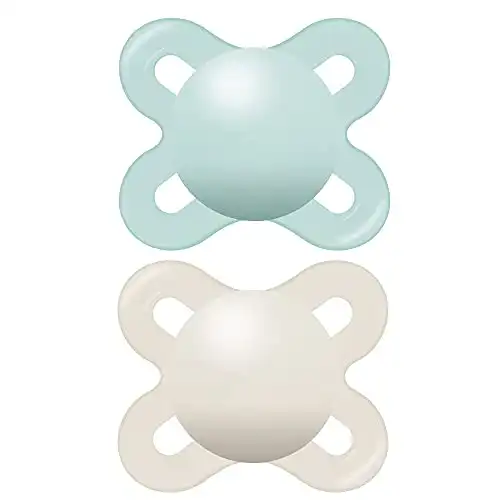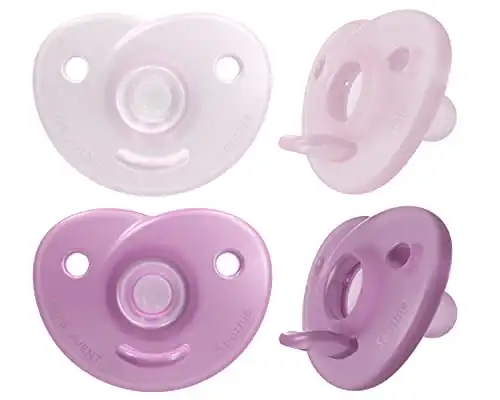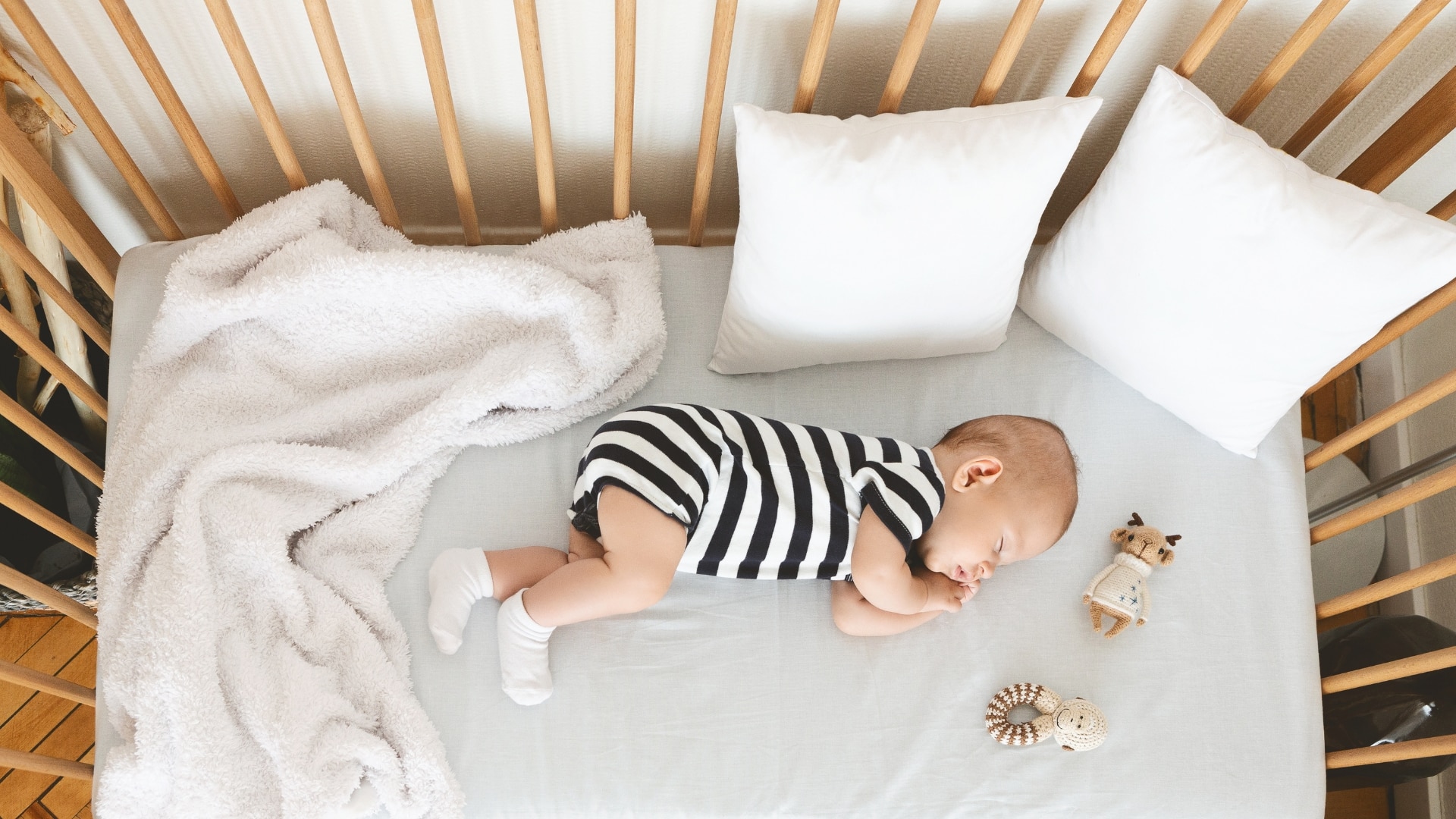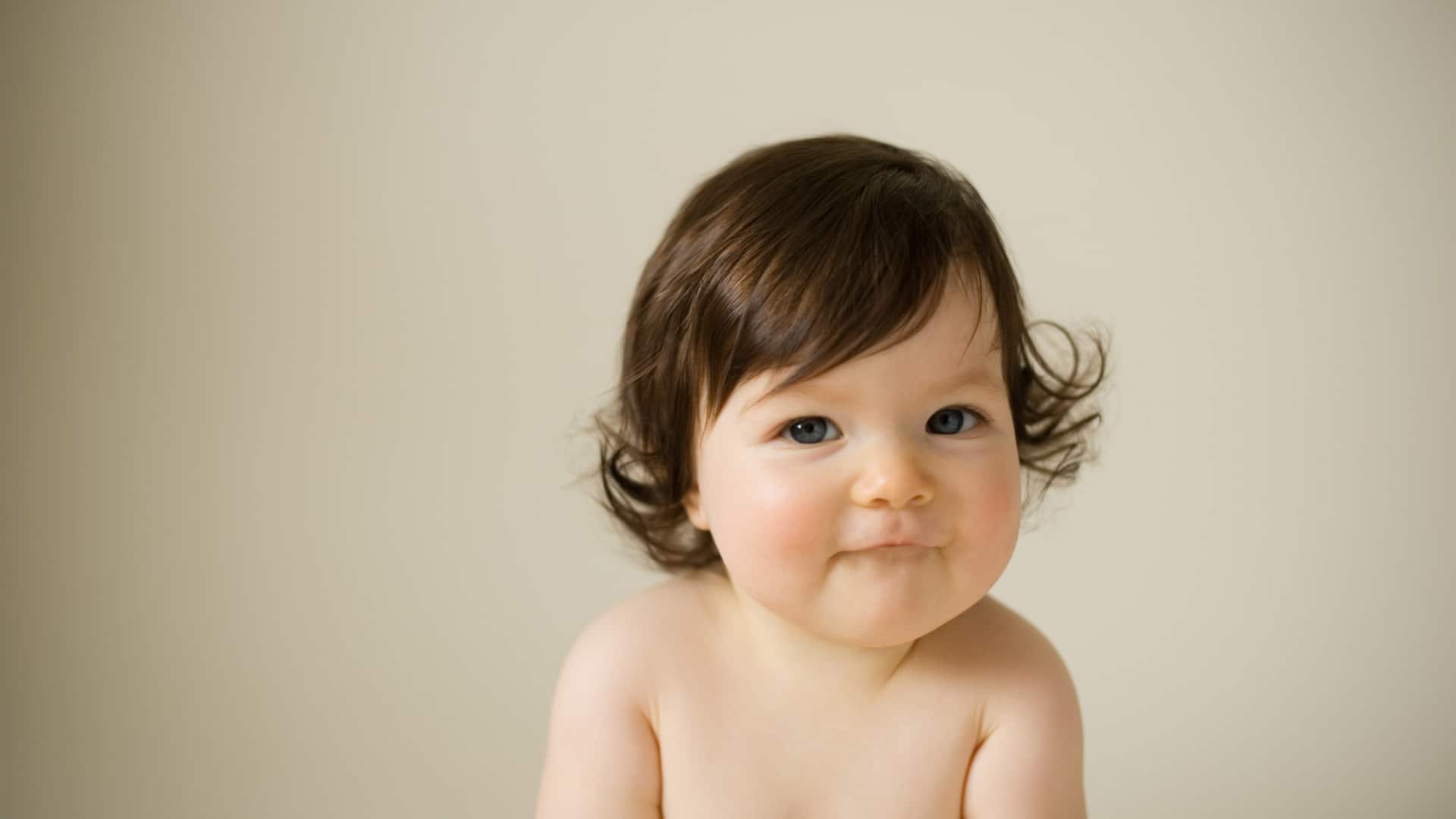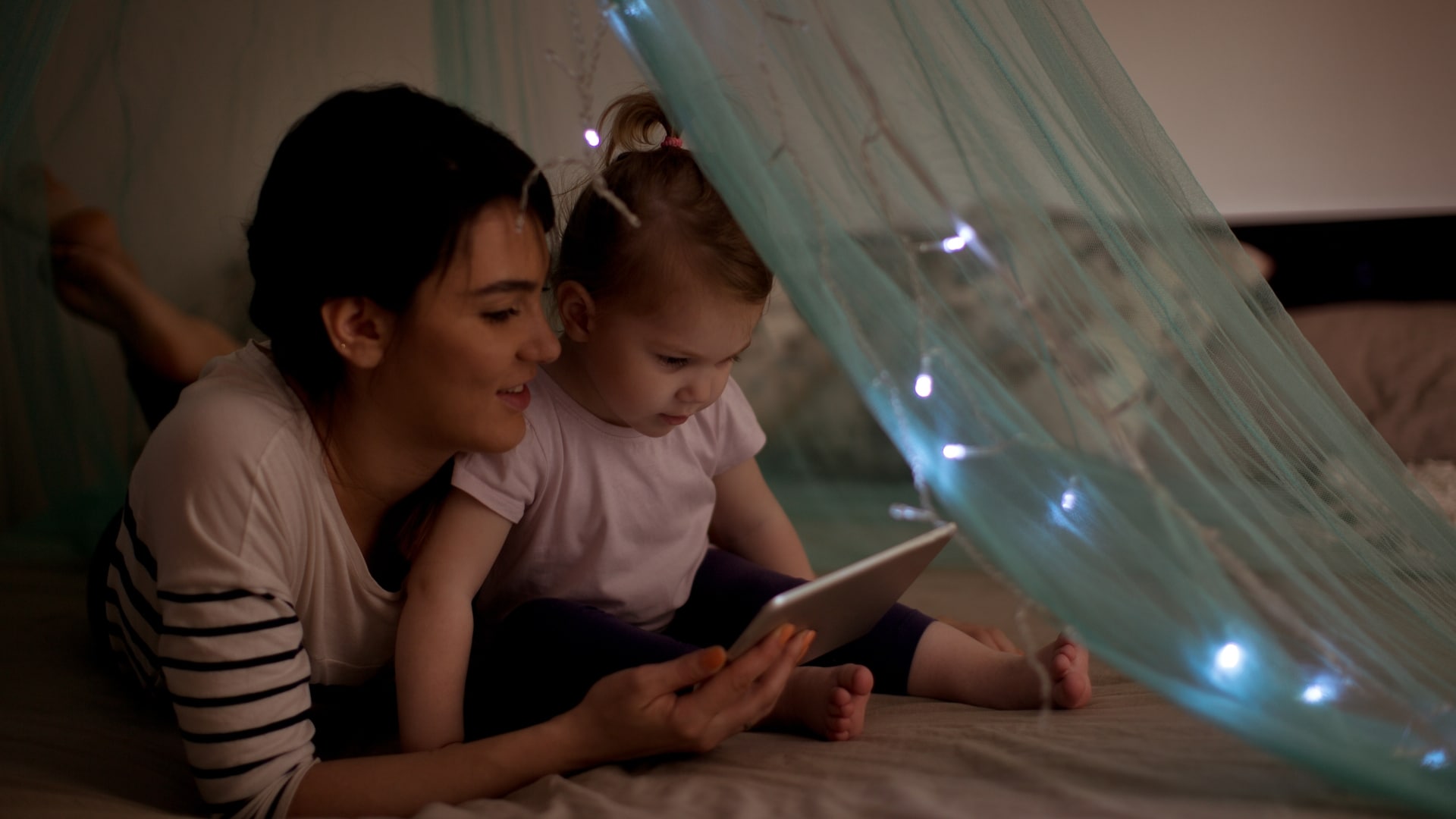As a new parent, you’re eager to help your little one get the restful sleep they need – so you can get the deep sleep you need too! A pacifier can be a helpful tool in this pursuit, but how can you use it to aid with sleep training?
In this guide, we’ll explore sleep training with a pacifier, including tips, tricks, and best practices for success. Whether you’re a first-time mom or dad feeling overwhelmed or a seasoned parent seeking new strategies, keep reading for everything you need to know about using a pacifier to help your baby sleep better.
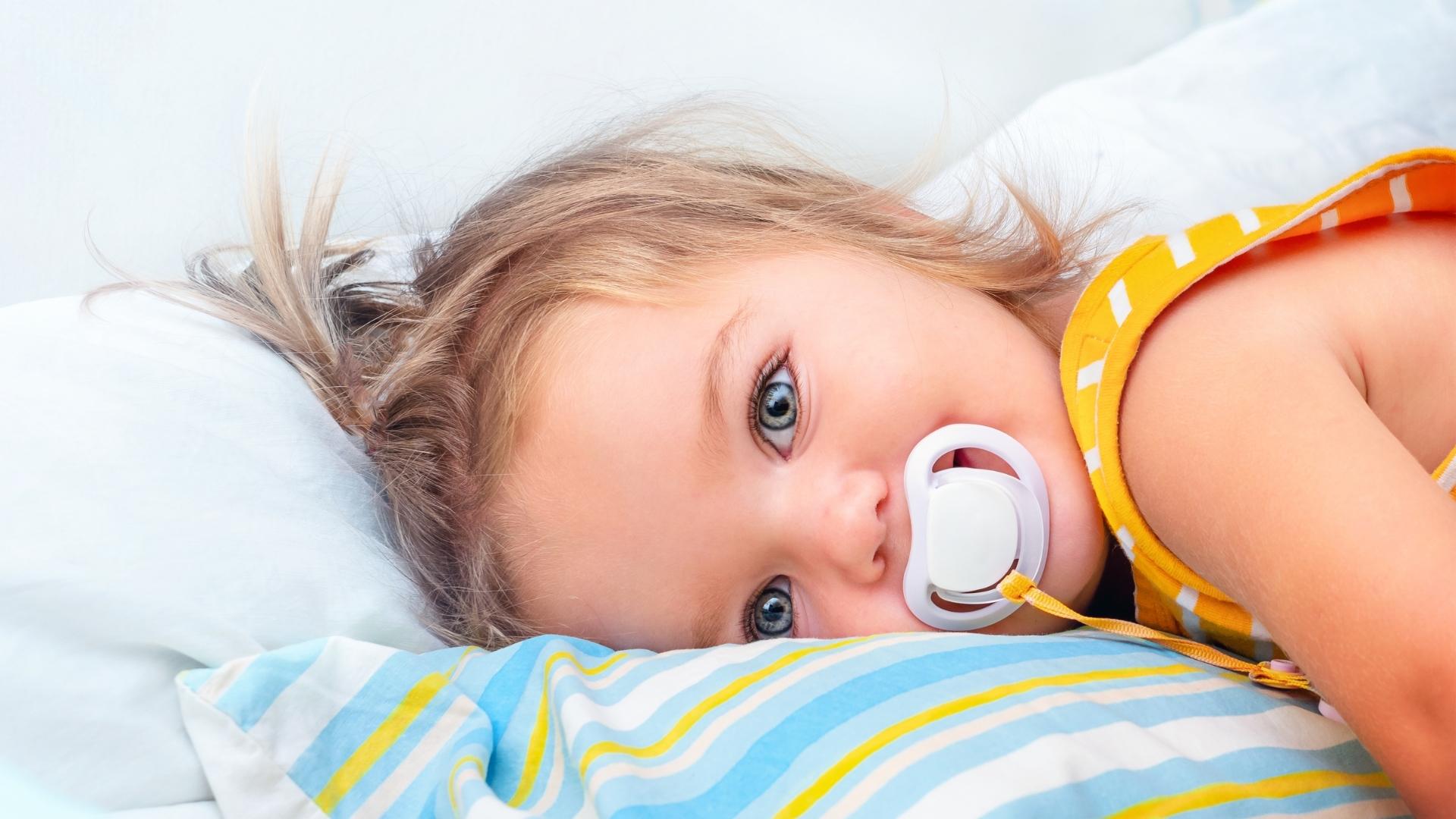
Table of Contents
Key Takeaways
- Pacifiers can be helpful tools for sleep training, as they help soothe babies and teach them to self-settle. However, they should not be used long-term or as a sleep prop.
- When introducing a pacifier, wait until breastfeeding is well established, around 3-4 weeks old, to avoid nipple confusion. For bottle-fed babies, pacifiers can be introduced at any age.
- When sleep training with a pacifier, always follow safe sleep practices and consult a pediatrician before changing your baby’s sleep patterns dramatically.
What Is Sleep Training?
Sleep training is the process of teaching your baby to fall asleep on their own and to stay asleep through the night. Although there are lots of different methods, at its core, sleep training is a technique that helps babies learn to self-soothe and establish healthy sleep habits.
The Role of Pacifiers in Sleep Training
When it comes to getting your baby to fall asleep quickly and stay asleep without your presence, sleep training with a pacifier can be a very useful tool.
While some parents may naturally worry that using a pacifier for sleep will make it harder to teach their baby to fall asleep on their own in the long run…
The truth is that pacifiers can help soothe babies and make the sleep training process easier.
When used appropriately, pacifiers can be very helpful and can aid in the development of healthy sleep habits.
However, it is important to note that pacifiers should not be used as a long-term solution for sleep.
Instead, they should be used as a temporary tool to help your baby learn to self-soothe and fall asleep on their own with the aim of weaning them off the pacifier once their good sleep habits and sleep schedule are well established.
You should ideally wean baby off their pacifier by 6 months of age.
Finally, The Sleep Foundation says that “Research suggests non-nutritive sucking, such as on a pacifier, may support healthy baby sleep.”
Using a pacifier during sleep also appears to significantly lower a baby’s risk of sudden infant death syndrome (SIDS), although researchers still do not understand the specific reason why.
My Experience Of Sleep Training With A Pacifier
I have to admit that when I did my Norland Training 40 years ago, the trend was anti-pacifiers.
So, I battled through many jobs sleep training without a pacifier as I was taught to prefer thumb-sucking.
Thankfully, opinions have changed and I am now an advocator of sleep training with a pacifier and the role pacifiers play in helping babies sleep.
You see, my son was a thumb sucker, and getting him to stop was almost impossible.
He ended up having orthodontic treatment to rectify the damage done by his thumb sucking… A situation I do not wish on any family.
It is a lot easier to wean your baby off a pacifier and as they definitely help young babies sleep and learn to self-settle, I would recommend them to any parent who is struggling to get their baby down to sleep!
Keep reading to learn how I sleep train with a pacifier (PS: I do not recommend the cry-it-out method).
NOTE: Not all babies will take to a pacifier and not all babies will need them to learn to self settle… but they can be a very useful tool if used correctly. I would also advocate that pacifiers should only be used to help your little one fall asleep NOT as a means to calm them in every situation as they grow up.
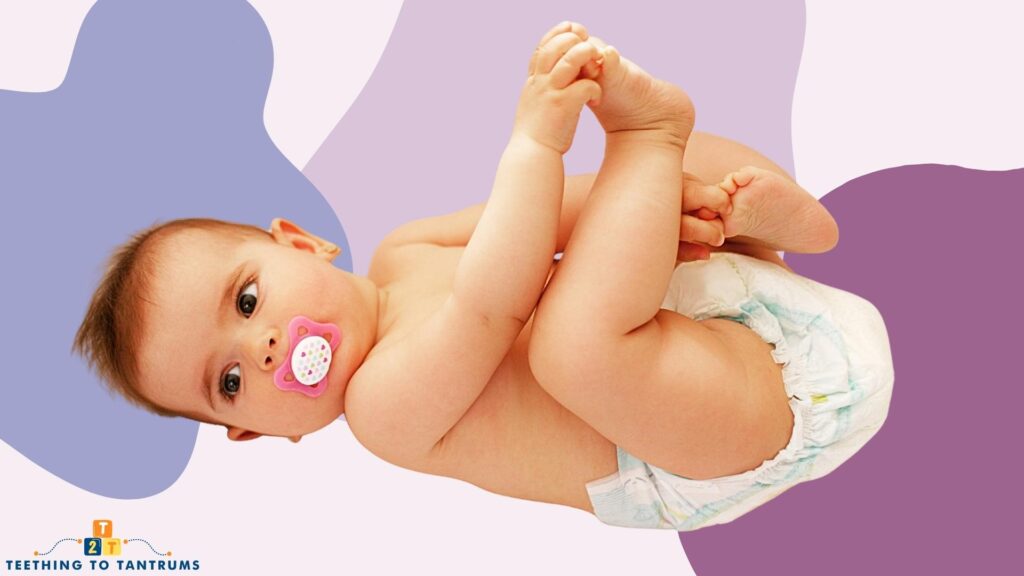
Sleep Training Methods With A Pacifier
When it comes to sleep training with a pacifier, you need to remember that regardless of what sleep training method you use, unless your baby is old enough to put the pacifier in their mouth for themselves, you will have to do it for them when it falls out (potentially several times a night).
My Preferred Method Of Sleep Training With A Pacifier:
I love the Pick Up, Put Down method for sleep training young babies. Here’s how I would do sleep training with a pacifier for little ones:
- Start by trying to settle your baby without the pacifier. This means putting them down when they’re drowsy and seeing if they will settle with only you shussing them or patting them gently.
- If baby does not settle, try using a pacifier. Again, keep the interactions low-key, pat their tummy, and gently shush. Try to avoid picking up your baby as you want the comfort to come from the pacifier, not your arms.
- When baby settles, wait by their crib for a short while. Gradually move away from the crib until you are out of the room.
- If baby whines when you are gone, wait a few minutes before returning to soothe baby. Ideally, you should settle baby back to sleep by rubbing their tummy, gently patting them or holding their hand. Try to avoid picking them up unless they are in distress
- If you do pick baby up, restart this sleep training process from step 1.
It’s always important to consider your baby’s sleep associations and how they may be affecting their sleep cycles and ability to sleep through the night.
Not all babies will respond to the same sleep training method, and what works for one family may not work for another. It’s essential to find a method that works for you and your baby.
So if my method doesn’t work, feel free to try this pacifier-compatible sleep training method:
The Ferber Method With A Pacifier
The Ferber Method involves gradually increasing the amount of time you let your baby cry before going in to soothe them. You can use a pacifier as a tool to help soothe your baby during this process.
- Developed by pediatric sleep expert Dr. Richard Ferber, start by putting your baby to bed at the end of their regular bedtime routine, saying good night, and leaving them to fall asleep independently.
- If they begin to whine, wait about 2 minutes then reenter the room, calmly resettle your baby (without picking up or making a big fuss), say good night, and leave again.
- Repeat as many times as necessary. Gradually increase the amount of time you wait before reentering the room night after night.
The Ferber method gives children the opportunity to learn to fall asleep on their own and is usually considered a gentle sleep training method. If you decide to try this method of sleep training with a pacifier, settle baby to sleep with one from the beginning.
Remember to be patient and understanding as your baby learns to settle and sleep through the night. Achieving a full night’s sleep will take time.
Choosing The Right Pacifier
When choosing a pacifier, it is important to consider the size and type that is appropriate for your baby’s age and development.
There are a large variety of pacifiers on the market these days and the choice can often be overwhelming.
From orthodontic pacifiers designed to support the natural development of your baby’s mouth and teeth to glow-in-the-dark pacifiers (which are designed to help parents find lost pacifiers in the middle of the night), there are lots to choose from!
To help make your life easier, I’ve done a load of research for you. Here are my top pacifiers available on the market today:
|
Primary Rating:
5.0
|
Primary Rating:
4.5
|
Primary Rating:
4.5
|
|
Description: These cute dishwasher-safe orthodontic pacifiers have a teat that is designed to allow for a natural sucking motion, reducing pressure on the jaw and teeth, and preventing teeth misalignment! Their heart-shaped shield also fits perfectly under baby’s nose for easy breathing making them the perfect pacifier for your baby! |
Description: Designed for breastfed babies, these pacifiers feature a symmetrical shape meaning there's no "wrong way up" and the specially designed BPA-free silicone teat promotes healthy oral development. Plus, the included sterilizing pacifier case makes it easy to keep them clean and ready for use! Plus, they come in fabulous matte pastel colors. |
Description: Designed by doctors and used in hospitals nationwide, this pacifier is made of medical-grade silicone and promotes natural oral development. Its one-piece design makes it easy to clean and sterilize (dishwasher safe!) and it's construction is specially sized and shaped for babies 0-3 months old. It's a classic pacifier for young babies. |
These cute dishwasher-safe orthodontic pacifiers have a teat that is designed to allow for a natural sucking motion, reducing pressure on the jaw and teeth, and preventing teeth misalignment! Their heart-shaped shield also fits perfectly under baby’s nose for easy breathing making them the perfect pacifier for your baby!
Designed for breastfed babies, these pacifiers feature a symmetrical shape meaning there's no "wrong way up" and the specially designed BPA-free silicone teat promotes healthy oral development. Plus, the included sterilizing pacifier case makes it easy to keep them clean and ready for use! Plus, they come in fabulous matte pastel colors.
Designed by doctors and used in hospitals nationwide, this pacifier is made of medical-grade silicone and promotes natural oral development. Its one-piece design makes it easy to clean and sterilize (dishwasher safe!) and it's construction is specially sized and shaped for babies 0-3 months old. It's a classic pacifier for young babies.
REMEMBER: It is also important to note that pacifiers should be used safely and appropriately. They should never be tied around your baby’s neck. And pacifiers should be cleaned regularly to prevent the buildup of bacteria.
Potential Challenges When Sleep Training With A Pacifier
Sleep training with a pacifier can be a helpful tool for parents, but it can also present some challenges. Here are some potential issues you may encounter and some tips for troubleshooting them:
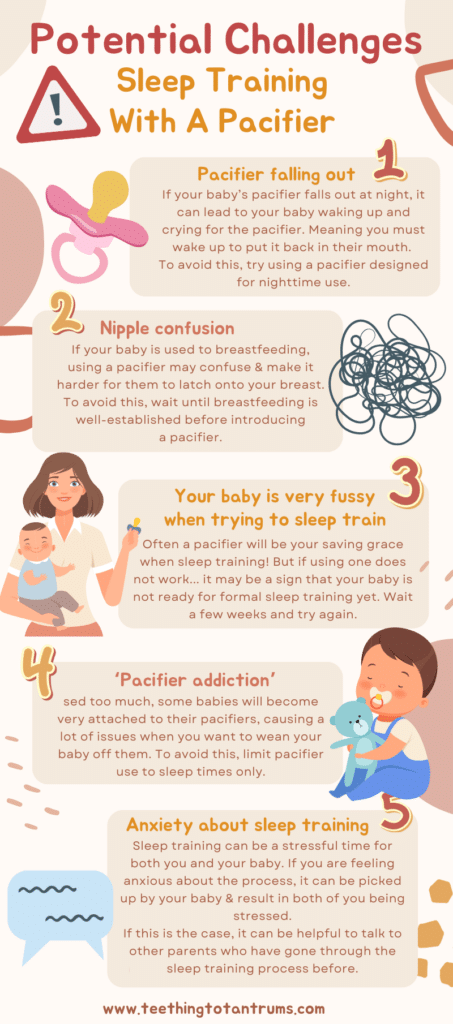
1. Pacifier Falling Out
As I’ve already mentioned, one common issue of sleep training with a pacifier is that it may fall out of your baby’s mouth during the night.
This can lead to your baby waking up and crying for the pacifier. To avoid this, try using a pacifier designed for nighttime use, which may be larger and less likely to fall out of your baby’s mouth.
2. Nipple Confusion
Another potential challenge with using a pacifier during sleep training is nipple confusion. If your baby is used to breastfeeding, using a pacifier may confuse and make it harder for your baby to latch onto your breast.
To avoid this, try waiting until breastfeeding is well-established before introducing a pacifier.
My rule of thumb is:
- Babies who are breastfeeding and who have no trouble latching can be introduced to a pacifier at 3-4 weeks old.
- For babies that are having trouble latching, introduce a pacifier at 4+ weeks.
- For bottle-fed babies, you can introduce a pacifier at any age.
You can also try using a pacifier that is specifically designed for breastfed babies, like this set from MAM:
Designed for breastfed babies, these pacifiers feature a symmetrical shape meaning there's no "wrong way up" and the specially designed BPA-free silicone teat promotes healthy oral development. Plus, the included sterilizing pacifier case makes it easy to keep them clean and ready for use! Plus, they come in fabulous matte pastel colors.
3. Fussy Baby
If your baby is super fussy and crying during sleep training, it can be difficult to know what to do.
Often a pacifier will be your saving grace! But if using one does not work… it may be a sign that your baby is not ready for sleep training of any type yet.
In this case, it may be best to wait a few weeks or even months before trying a pacifier again. It is also worth trying a few different pacifiers to see what works best for you and your baby.
4. Pacifier Addiction
Whilst sleep training with a pacifier is a useful tool… There can be too much of a good thing!
If your baby get used to having a pacifier throughout the day, they may become very attached to their pacifier, causing a lot of issues when you want to wean your baby off them.
However, as I said earlier, it’s far easier to wean a baby off a pacifier than their thumb! (As you are in control of when a pacifier is offered).
Remember, whilst pacifiers can be absolute lifesavers, be conscious of your baby’s pacifier usage.
5. Anxiety
Sleep training can be a stressful time for both you and your baby. If you are feeling anxious about the process, this can be picked up by your baby and result in you both being stressed.
If this is the case, it can be helpful to talk to other parents who have gone through the sleep training process before.
You can also try practicing relaxation techniques, such as deep breathing or meditation, to help calm your nerves.
Looking to get your little one to sleep quickly and effortlessly? Check out my Bedtime and Nap Cheat Sheet and master the art of making daytime naps and bedtimes as seamless as possible.
A bedtime & nap cheat sheet so good your little one will ask you to put them to bed...
Laura Williams "This is a life saver! I'm so glad I downloaded your bedtime & nap cheat sheet. My little one actually asked me to put him to bed last night! Unbelievable! Thank you so much!"
Click Here For The FREE Cheat Sheet
Safety Considerations When Sleep Training With A Pacifier
When it comes to sleep training with a pacifier, safety should always be your top priority. Here are some key safety considerations to keep in mind:
- Avoid pacifier tethering clips or cords. Pacifier cords can pose a choking hazard if they become wrapped around your baby’s neck when they sleep. Instead, have multiple pacifiers available in the crib or find a safe alternative.
- Ensure the pacifier has breathing holes in the guard and is appropriately shaped to fit comfortably under baby’s nose to ensure baby’s breathing is not affected when using a pacifier.
- Follow the American Academy of Pediatrics (AAP) safe sleep guidelines. The AAP recommends that babies sleep on their backs to reduce the risk of Sudden Infant Death Syndrome (SIDS). Make sure your baby’s sleep environment is safe and free of any loose bedding or objects that could pose a suffocation risk.
- Talk to your pediatrician or sleep consultant. Before starting any sleep training method, it’s always a good idea to consult with your pediatrician. They can help you determine if your baby is ready for sleep training and provide guidance on safe sleep practices.
- Watch for signs of ear infections. Pacifiers have been linked to an increased risk of ear infections, so it’s important to watch for signs of ear pain or other symptoms. If your baby is prone to ear infections, talk to your pediatrician about whether pacifiers are the right choice for your family.
By keeping these safety considerations in mind, you can help ensure that sleep training with a pacifier is a safe and effective option for your family.
Frequently Asked Questions About Sleep Training With A Pacifier
Looking for more information about sleep training with a pacifier? Here are the most commonly asked questions, answered just for you.
Q: Is it okay to use a pacifier during sleep training?
A: Yes, it is okay to use a pacifier during sleep training, as long as it’s used safely and appropriately. Pacifiers can help soothe babies and make it easier for them to fall asleep, but they can also become a sleep crutch and hinder the sleep training process if they are overused. It’s important to use pacifiers as a tool, not a prop, during sleep training.
Q: How can I wean my baby off of pacifiers during sleep training?
A: If you want to wean your baby off of pacifiers during sleep training, you can try gradually reducing the amount of time your baby uses the pacifier each night until they no longer need it. You can also try offering other soothing techniques such as white noise to help your baby fall asleep.
Q: Does a pacifier help with sleep regression?
A: Pacifiers can help soothe babies during a sleep regression, but they can also become a sleep crutch and hinder the sleep training process if they are overused. To learn more about how to handle a sleep regression, read these posts:
- Sleep Regression: What, Why, Signs & Sanity-Saving Solutions.
- 3-Month Sleep Regression
- 4-Month Sleep Regression
- 5-Month Sleep Regression
Q: Can taking away a pacifier cause sleep issues?
A: Taking away a pacifier can cause sleep issues in the short term, as your baby may become more fussy and have trouble falling asleep without it.
However, if you gradually wean your baby off of the pacifier and teach them to self-soothe using other sleep associations, they will eventually be able to fall asleep without it.
Q: Can a swaddled baby safely sleep with a pacifier?
A: Yes, a swaddled baby can safely sleep with a pacifier, as long as the pacifier is used safely and appropriately. Bear in mind, that if baby’s arms are within the swaddle, you will need to replace their pacifier should it fall out.
Q: How do I teach my baby to self-soothe with a pacifier?
A: Teaching your baby to self-soothe with a pacifier can be a helpful tool in your sleep training plans. Here are some steps you can follow:
- Introduce the pacifier early: Start offering a pacifier to your baby early on, so they can get used to the sensation and learn to associate it with comfort.
- Use the pacifier as part of a sleep routine: Incorporate the pacifier into your baby’s sleep routine, so they learn to associate it with sleep. For example, you could offer a pacifier at bedtime after reading a story or singing a lullaby.
- Encourage your baby to hold the pacifier: As your baby gets older, encourage them to hold the pacifier themselves. This can help them learn to self-soothe and put themselves back to sleep if they wake up in the middle of the night.
- Gradually wean your baby off the pacifier: Once your baby is able to self-soothe and fall asleep without the pacifier, you can start to gradually wean them off it. This can be a gradual process, such as removing the pacifier for shorter and shorter periods of time, until your baby no longer needs it to fall asleep.
Q: How can I get my baby to self-soothe WITHOUT a pacifier?
A: As this is how I spent the last 40 years teaching babies to settle, I can absolutely say that yes, teaching your baby to self-soothe without a pacifier is possible! However, it may take some time and patience. Here are some tips to help your baby learn to self-soothe:
- Establish a consistent sleep routine: A consistent bedtime routine can help your baby learn to associate certain actions with sleep, such as a bath, a bedtime story or singing a lullaby.
- Encourage independent sleep: Try to put your baby down to sleep while they’re drowsy but still awake, so they can learn to fall asleep on their own.
- Use a transitional object: A transitional object, such as a soft blanket or stuffed animal, can provide comfort and help your baby feel secure (especially if it smells of you).
- Practice responsive settling: If your baby wakes up in the middle of the night, try to soothe them back to sleep without picking them up. This can help them learn to self-soothe and fall back asleep on their own as they grow. I like shushing noises and gently patting baby on their tummy.
Need More Parenting Help?
- Download our FREE Bedtime & Nap Sleep Cheat Sheet. It’s a free, easy-to-use and proven formula designed for parents of 0-5 year olds to master the art of consistently undisturbed and restful sleep without the yelling, nagging or exhausting long-winded evenings.
- Check out our Parenting Toolbox. You’ll get access to expertly-chosen products that you can guarantee are the best for your little one and your wallet.
- Are you looking for personalized guidance to navigate the challenges of parenting? I offer 1-on-1 consultations to bring you tailored strategies and actionable advice to help support your child's growth and well-being with confidence.

A bedtime & nap cheat sheet so good your little one will ask you to put them to bed...
Laura Williams "This is a life saver! I'm so glad I downloaded your bedtime & nap cheat sheet. My little one actually asked me to put him to bed last night! Unbelievable! Thank you so much!"
Click Here For The FREE Cheat Sheet
